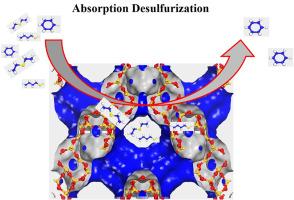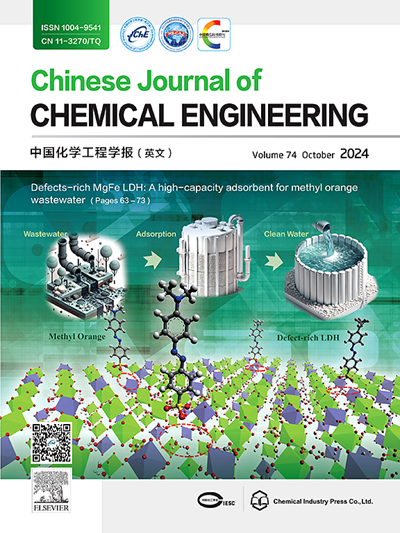Mechanisms of competitive adsorption and diffusion of ethyl sulfide and n-butyl mercaptan with cyclohexene in FAU: MC and MD
IF 3.7
3区 工程技术
Q2 ENGINEERING, CHEMICAL
引用次数: 0
Abstract
An in-depth understanding of the competition mechanism between olefins and different types of sulfides in gasoline is essential to improve the desulfurization selectivity of the adsorption desulfurization process (ADS). In this study, the competitive adsorption and diffusion mechanism of two systems, diethyl sulfide/cyclohexene and n-butyl mercaptan/cyclohexene, with different adsorption amounts in siliceous faujasite zeolite (FAU) were investigated by Monte Carlo (MC) and molecular dynamics (MD). The systems exhibited a two-stage loading-dependent competitive adsorption and diffusion mechanism, with an inflection point of 32 molecule/UC (moleculers per microcoulomb). Before the inflection point (4–32 molecule/UC), the competition mechanism of the two systems was the “optimal-displacement” mechanism. After the inflection point, the mechanism of the diethyl sulfide/cyclohexene changed to “relocation-displacement”, while that of the n-butyl mercaptan/cyclohexene system changed to “dominant-displacement”. Compared to ether functional groups, the alcohol functional group has higher polarity and stronger adsorption stability, thus occupying more favorable adsorption sites within the supercages (SCs), while ethyl sulfide shifts outward to other sites within other SCs. In addition, the diffusion performance of adsorbent is related to the adsorption energy. The lower the adsorption energy, the weaker the diffusion ability. Meanwhile, the diffusion performance of adsorbates is better at high temperatures and low adsorption capacity. The effect of temperature on the desulfurization selectivity was determined. A lower temperature is favorable for the adsorption capacity of the two systems and the removal selectivity of sulfides. This study provides fundamental insights into the competitive adsorption and diffusion mechanisms among sulfides, mercaptans and olefins, offering theoretical guidance for adsorbent design and reaction temperature optimization.

环己烯在FAU中竞争性吸附和扩散硫化物乙酯和正丁醇的机理:MC和MD
深入了解汽油中烯烃与不同类型硫化物的竞争机制,对提高吸附脱硫工艺的脱硫选择性至关重要。采用蒙特卡罗(MC)和分子动力学(MD)研究了不同吸附量的硫化二乙酯/环己烯和正丁基硫醇/环己烯两种体系在硅质faujasite沸石(FAU)上的竞争吸附和扩散机理。该系统表现出两阶段负载依赖的竞争吸附和扩散机制,拐点为32分子/UC(分子/微库仑)。在拐点(4-32分子/UC)之前,两体系的竞争机制为“最优置换”机制。拐点后,硫化二乙酯/环己烯体系的反应机理变为“重位-位移”,正丁醇/环己烯体系的反应机理变为“显性-位移”。与醚官能团相比,醇官能团具有更高的极性和更强的吸附稳定性,因此在超笼(SCs)中占据更有利的吸附位置,而硫化物乙酯则向外移动到其他SCs中的其他位置。此外,吸附剂的扩散性能与吸附能有关。吸附能越低,扩散能力越弱。同时,在高温低吸附量条件下,吸附剂的扩散性能较好。考察了温度对脱硫选择性的影响。较低的温度有利于两种体系的吸附能力和对硫化物的去除选择性。该研究为硫化物、硫醇和烯烃之间的竞争吸附和扩散机制提供了基础认识,为吸附剂设计和反应温度优化提供了理论指导。
本文章由计算机程序翻译,如有差异,请以英文原文为准。
求助全文
约1分钟内获得全文
求助全文
来源期刊

Chinese Journal of Chemical Engineering
工程技术-工程:化工
CiteScore
6.60
自引率
5.30%
发文量
4309
审稿时长
31 days
期刊介绍:
The Chinese Journal of Chemical Engineering (Monthly, started in 1982) is the official journal of the Chemical Industry and Engineering Society of China and published by the Chemical Industry Press Co. Ltd. The aim of the journal is to develop the international exchange of scientific and technical information in the field of chemical engineering. It publishes original research papers that cover the major advancements and achievements in chemical engineering in China as well as some articles from overseas contributors.
The topics of journal include chemical engineering, chemical technology, biochemical engineering, energy and environmental engineering and other relevant fields. Papers are published on the basis of their relevance to theoretical research, practical application or potential uses in the industry as Research Papers, Communications, Reviews and Perspectives. Prominent domestic and overseas chemical experts and scholars have been invited to form an International Advisory Board and the Editorial Committee. It enjoys recognition among Chinese academia and industry as a reliable source of information of what is going on in chemical engineering research, both domestic and abroad.
 求助内容:
求助内容: 应助结果提醒方式:
应助结果提醒方式:


